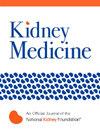Body Mass Index in Late Adolescence and Later Life Kidney Outcomes: A Population-Based Cohort Study in Swedish Men
IF 3.4
Q1 UROLOGY & NEPHROLOGY
引用次数: 0
Abstract
Rationale & Objective
The association between body mass index (BMI) and chronic kidney disease (CKD) is well established in middle-aged and older adults. Here, we assess the association of BMI in late adolescence with CKD, kidney failure, and acute kidney injury (AKI) later in life.
Study Design, Setting & Participants
Population-based cohort study including data from the Swedish Conscription Database, the National Patient Register, the Cause of Death Register, and Statistics Sweden. Conscripts with no history of diabetes, cardiovascular, kidney, or rheumatic diseases enlisted between 1969 and 1997 were followed until December 31, 2019.
Main Outcomes & Exposures
The study examined the impact of BMI on kidney outcomes. The primary outcome was incident chronic kidney disease. Secondary outcomes were stage 5 chronic kidney disease, end-stage kidney disease, and acute kidney injury.
Analytical Approach
Patients were stratified into the quintiles of BMI at conscription, and followed until events, death, or censoring, using Cox proportional hazards model, adjusted for baseline systolic and diastolic blood pressure, proteinuria, and socioeconomic factors.
Results
In total, 1,321,481 male participants with a mean age of 18.3 years and a mean BMI of 21.6 kg/m2 were followed for an average of 35.6 years, generating a total of 47 million person-years of follow-up. During this period, the incidence of CKD-based on diagnosis codes was 5,590, whereas 2,357 subjects were diagnosed with end-stage kidney disease and 8,023 with AKI, respectively. The risk for CKD was increased for the fourth and fifth highest BMI quintile relative to the lowest (adjusted hazard ratio [aHR] 1.23; 95% confidence interval [CI], 1.13-1.35 for BMI 21.9-23.5 kg/m2; aHR 2.09; 95% CI, 1.93-2.26 for BMI >23.5 kg/m2). Patterns were similar for stage 5 CKD and end-stage kidney disease, whereas the risk for AKI was evident at the third and higher quintiles (aHR 1.14; 95% CI, 1.06-1.23 for BMI 20.7-21.9 kg/m2; aHR 1.31; 95% CI, 1.22-1.41 for BMI 21.9-23.5 kg/m2; and aHR 1.92; 1.79-2.05 for BMI ≥23.5 kg/m2).
Limitations
A retrospective observational study of male Swedish adolescents.
Conclusions
The findings of this study indicate that, for prevention of kidney disease, the optimal BMI in adolescence with reference to kidney outcomes is likely in the low-normal range.
Plain Language Summary
This study investigates the long-term link between body mass index (BMI) during late adolescence and kidney failure and acute kidney injury. It draws from a large, population-based Swedish cohort, tracking over a million young men over decades. The research shows that higher BMI in adolescence is associated with an increased risk of kidney problems as adults, with those in the higher BMI ranges facing a significantly greater chance of developing chronic kidney disease and acute kidney injury. The risk was particularly high for individuals with higher BMI levels. These findings suggest that maintaining a low-normal BMI during adolescence may help prevent kidney-related diseases later in life.
青春期晚期体重指数与晚年肾脏结局:瑞典男性人群队列研究
基本原理及目的体重指数(BMI)与慢性肾脏疾病(CKD)之间的关系在中老年人群中得到了很好的确立。在这里,我们评估了青春期晚期BMI与生活后期CKD、肾衰竭和急性肾损伤(AKI)的关系。研究设计、设置和;参与者:以人群为基础的队列研究,包括来自瑞典征兵数据库、国家患者登记册、死因登记册和瑞典统计局的数据。在1969年至1997年期间,没有糖尿病、心血管、肾脏或风湿病史的应征入伍者被跟踪到2019年12月31日。主要成果&;该研究调查了体重指数对肾脏预后的影响。主要结局是慢性肾脏疾病的发生。次要结局是5期慢性肾病、终末期肾病和急性肾损伤。采用Cox比例风险模型对征兵时的BMI进行分层,随访至事件、死亡或筛查,并根据基线收缩压和舒张压、蛋白尿和社会经济因素进行调整。结果共有1321481名男性参与者,平均年龄18.3岁,平均BMI为21.6 kg/m2,平均随访35.6年,共产生4700万人年的随访。在此期间,基于诊断代码的ckd发病率为5590例,而诊断为终末期肾病的受试者分别为2357例和AKI患者8023例。相对于BMI最低的五分位数而言,第四和第五高的五分位数患CKD的风险增加(调整后的风险比[aHR] 1.23;BMI为21.9 ~ 23.5 kg/m2, 95%置信区间为1.13 ~ 1.35;aHR 2.09;95% CI为1.93-2.26 (BMI = 23.5 kg/m2)。5期CKD和终末期肾脏疾病的模式相似,而AKI的风险在第三和更高的五分位数(aHR 1.14;BMI为20.7 ~ 21.9 kg/m2, 95% CI为1.06 ~ 1.23;aHR 1.31;BMI为21.9 ~ 23.5 kg/m2, 95% CI为1.22 ~ 1.41;aHR 1.92;BMI≥23.5 kg/m2为1.79 ~ 2.05)。局限性:对瑞典男性青少年进行回顾性观察研究。结论本研究结果表明,对于肾脏疾病的预防,青春期的最佳BMI与肾脏预后相关,可能处于低正常范围。本研究探讨了青少年晚期身体质量指数(BMI)与肾衰竭和急性肾损伤之间的长期联系。它来自一个庞大的、以人口为基础的瑞典队列,在几十年里跟踪了100多万年轻男性。研究表明,青少年时期较高的身体质量指数与成年后患肾脏疾病的风险增加有关,身体质量指数较高的人患慢性肾脏疾病和急性肾损伤的几率明显更高。对于身体质量指数较高的人来说,这种风险尤其高。这些发现表明,在青春期保持较低的正常体重指数可能有助于在以后的生活中预防肾脏相关疾病。
本文章由计算机程序翻译,如有差异,请以英文原文为准。
求助全文
约1分钟内获得全文
求助全文

 求助内容:
求助内容: 应助结果提醒方式:
应助结果提醒方式:


